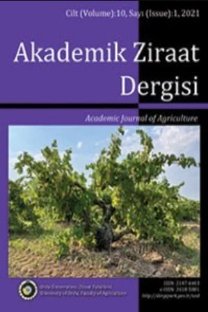Farklı Saklama Süresi ve Sıcaklıklarının Fındıkta (Corylus avellana L.) Polen Canlılığı Üzerindeki Etkisi
fındık, polen, polen saklama, polen canlılığı, yapay tozlaşma
Effect of Different Storage Times and Temperatures on Pollen Viability of Hazelnut (Corylus avellana L.)
Artificial pollination, hazelnut, pollen storage, pollen viability, pollen,
___
- Akond, A. M., Pounders, C. T., Blythe, E. K., & Wang, X. (2012). Longevity of crapemyrtle pollen stored at different temperatures. Scientia Horticulturae, 139, 53-57.
- Aldahadha, A., Samarah, N., & Bataineh, A. (2020). Effect of storage temperature and duration on pollen viability and in vitro germination of seven pistachio cultivars. Journal of Applied Horticulture, 22(3), 111-114.
- Ascari, L., Novara, C., Dusio, V., Oddi, L., & Siniscalco, C. (2020). Quantitative methods in microscopy to assess pollen viability in different plant taxa. Plant Reproduction, 33(3-4), 205-219.
- Dafni, A., & Firmage, D. (2000). Pollen viability and longevity: practical, ecological and evolutionary implications. Pollen and Pollination, 113-132.
- Dutta, S.K., Srivastav, M., Chaudhary, R., Lal, K., Patil, P., Singh, S. K., & Singh, A. K. (2013). Low temperature storage of mango (Mangifera indica L.) pollen. Scientia Horticulturae, 161, 193-197.
- Ferrando, N. A., Montiel, F. G., & Burgos, L. (2007). Influence of storage temperature on teh viability of sweet cherry pollen. Spanish Journal of Agricultural Research, (1), 86-90.
- Ge, Y., Fu, C., Bhandari, H., Bouton, J., Brummer, E.C., & Wang, Z.Y. (2011). Pollen viability and longevity of switchgrass (Panicum virgatum L.). Crop Science, 51(6), 2698-2705.
- Hoekstra, F.A., & Bruinsma, J. (1975). Respiration and vitality of binucleate and trinucleate pollen. Physiologia Plantarum, 34(3), 221-225.
- Impe, D., Reitz, J., Köpnick, C., Rolletschek, H., Börner, A., Senula, A., & Nagel, M. (2020). Assessment of pollen viability for wheat. Frontiers in Plant Science, 10, 1588.
- İslam, A. (2018). Hazelnut culture in Turkey. Akademik Ziraat Dergisi, 7(2), 259-266.
- İslam, A. (2019). Fındık ıslahında gelişmeler. Akademik Ziraat Dergisi, 8, 167-174.
- Liu, J., Zhang, H., Cheng, Y., Kafkas, S., & Güney, M. (2014). Pistillate flower development and pollen tube growth mode during the delayed fertilization stage in Corylus heterophylla Fisch. Plant Reproduction, 27(3), 145-152.
- Mehlenbacher, S.A., & Molnar, T.J. (2021). Hazelnut breeding. Plant Breeding Reviews, 45, 9-141.
- Mesnoua, M., Roumani, M., & Salem, A. (2018). The effect of pollen storage temperatures on pollen viability, fruit set and fruit quality of six date palm cultivars. Scientia Horticulturae, 236, 279-283.
- Novara, C., Ascari, L., La Morgia, V., Reale, L., Genre, A., & Siniscalco, C. (2017). Viability and germinability in long term storage of Corylus avellana pollen. Scientia Horticulturae, 214, 295-303.
- Olsen, J. L., Mehlenbacher, S. A., & Azarenko, A. N. (2000). Hazelnut pollination. HortTechnology, 10(1), 113-115.
- Shekari, A., Nazeri, V., & Shokrpour, M. (2016). Pollen viability and storage life in Leonurus cardiaca L. Journal of Applied Research on Medicinal and Aromatic Plants, 3(3), 101-104.
- Singh, S. P., Singh, S. P., Pandey, T., Singh, R. R., & Sawant, S. V. (2015). A novel male sterility-fertility restoration system in plants for hybrid seed production. Scientific Reports, 5(1), 11274.
- Toillon, J., Robin, J., Thomas, M., & Hamidi, R. (2023). Study on Nut Shell Lignification Progress in Hazelnut (Corylus avellana L.) cv. Segorbe. Journal of Nuts, 14(3), 191-199.
- Vaknin, Y., & Eisikowitch, D. (2000). Effects of short‐term storage on germinability of pistachio pollen. Plant Breeding, 119(4), 347-350.
- ISSN: 2147-6403
- Yayın Aralığı: Yılda 2 Sayı
- Başlangıç: 2012
- Yayıncı: Ordu Üniversitesi Ziraat Fakültesi
Düzce İli Fındık Bahçelerinde Tarımsal Uygulamalar ve Üreticilerin Pestisit Kullanım Durumu
Tuba BATUR, Zübeyde Filiz ARSLAN, Nedim ALTIN
Kalınkara Fındık Çeşidinde İç Meyve İriliğinin Biyoaktif Bileşikler Üzerine Etkisi
Fındık Meyvesi ile Yaprakların Mineral Bileşimleri Arasındaki İlişkiler
Tombul Fındıkta Rehabilitasyon Uygulamalarının Verim ve Kaliteye Etkileri
Ali İSLAM, Selim KARAGÖL, Valerio CRISTOFORI, Mercè ROVIRA
Xenon Test Cihazıyla Işığa Maruz Bırakılan β-Karoten Takviyeli Fındık Yağının Oksidasyon Kararlılığı
‘Çetiner’ Fındık (Corylus avellana L.) Çeşidinin Fenolojik, Pomolojik ve Morfolojik Özellikleri
Meryem Nur ŞENEL, Emin TAYLAN, Aysun AKAR
Tombul fındık çeşidinde yaş ve kuru meyvenin antimikrobiyal etkilerinin değerlendirilmesi
